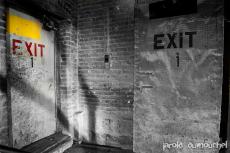It's over 92 years of industrial history that ended in 2004 when the Spexel factory was closed down. The story of this plant start in 1912 when is built the paper mill, which took the name of Howard Smith Paper Mill. Over the following years, the...
6240 Park Avenue
Omnipac, graffiti's school
The building, called the Omnipac, is for sale and the sellers offer a touch of humor to attract potential buyers. "Completely renovated," says the sign even if there is a graffiti invasion on every walls and all windows are missing. The place is closed, but easily accessible. The adjacent building was destroyed in April 2009, just when the Google car went there.
More, by reading the rental form of the building on the website of the company in charge of the sale, we discover that new architectural plans were produced for the renovation of the place. But, by seeing its current state, we guess that the project of the owner to convert into offices has been abandoned.

Look and feel of 6240 Park Avenue as shown on the Rosdev website
The building is 180,000 square feet over five floors. Four of which are dedicated for offices and the first floor for shops. At least that is what the estate agent says on its website. Remains to know how long the project will stay on the ice... if it's developped one day.
When entering the building, the first observation is that it's really empty. In fact, apart from the skeleton, there is nothing except graffitis. No division, nothing concrete, only standing water and peeling paint.
However, the light is interesting and the elements here and there on the floor offer good photos. The staircase leading to the roof is particularly interesting from a photographic point of view with its railway located a few steps from the building.
During our visit, despite the huge amount of graffiti we encountered only three people in these places, two of which came to play guitar (and probably to smoke a joint or two of marijuana).
Related content
From the outside, there is no indication that the plant is abandoned. No window is doomed and there is no "for sale" sign. Even the structure of the building is still in very good condition. I myself had doubts when I heard about it for the first...
Abandoned since December 1993, the former incinerator des Carrières, known as the incinerator # 3 is now partly used as a warehouse by the City of Montreal. It is also one of the few places where there have power in a portion of the building....
Destroyed in 2004, the Terken brewery was a huge industrial complex of more than four hectares. Located in the Union area in Roubaix, near Lille, the factory was, at one time, a symbol of "close symbiosis" between the company and its community...





























